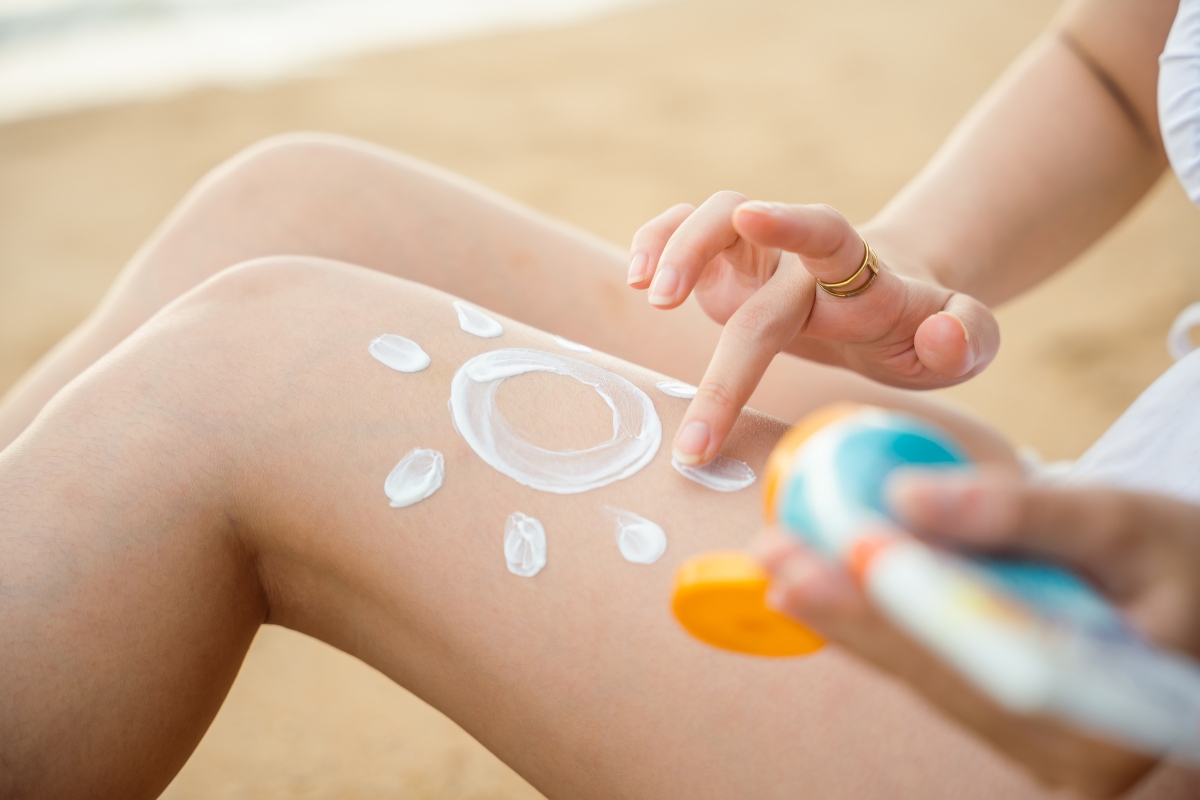Summer vacation by the sea is the culmination of annual rest for many people. Unfortunately, for some individuals, sun exposure by the sea can cause unpleasant skin problems. Sun allergy, also known as photodermatitis, is a condition that affects sensitive individuals who react to sun exposure. In this article, we will focus on sun allergy, its symptoms, causes, and treatment options. We will also discuss measures that can help minimize sun exposure and reduce the risk of allergic reactions.

What Is Sun Allergy?
Sun allergy, also known as photodermatitis or polymorphic light eruption (PLE), is an unwanted skin reaction to UV radiation. It is typically characterized by itchy and reddish bumps, plaques, or blisters on sun-exposed skin, which appear 30 minutes to several hours after sun exposure.

How Does Sun Allergy Differ from Sunburn?
Unlike common sunburn, which manifests as redness and gradual peeling of the outer layer of the skin, sun allergy triggers the eruption of small bumps or blisters. In individuals with a more severe form of allergy, these lesions can merge into larger swollen areas. Symptoms usually appear a few minutes to hours after sun exposure and are most commonly localized on the arms, face, and often in the décolleté area.
What Is Photodermatitis?
Photodermatitis is a general term for a group of skin conditions that manifest as unwanted reactions to sunlight. Sun allergy, also known as polymorphic light eruption (PLE), represents the most common form of photodermatitis. It is typically characterized by non-damaging, itchy, reddish bumps, plaques, or blisters on sun-exposed skin, which appear 30 minutes to several hours after sun exposure.
This condition, photodermatitis, requires careful protection against sunlight. Physicians and dermatologists recommend wearing sun-protective clothing with UV filters, sunglasses, and using broad-spectrum sunscreens with a high sun protection factor. Additionally, it is important to avoid direct sunlight during the period of highest intensity, typically between 10:00 AM and 4:00 PM. In case of symptoms of sun allergy, individuals should seek professional medical help and consult on further treatment and prevention options.

Symptoms of Sun Allergy Not Only at the Seaside
Sun allergy primarily affects the skin, but it can also impact the overall health of the affected person. The most common symptoms include:
- Skin rash: A rash is one of the most typical symptoms of sun allergy. The affected area may become red, and blisters or itching may appear. In more severe cases, the rash can progress to eczema.
- Itching and burning: Allergic reactions to the sun often involve itching and burning of the skin. This unpleasant sensation can be intense in certain areas and cause significant discomfort.
- Swelling and edema: Some people with sun allergy may experience swelling and edema, particularly on the face, hands, and feet.
- Headaches and fatigue: Allergic reactions to the sun can also cause unpleasant symptoms such as headaches and overall fatigue.
- Digestive problems: Sun exposure can lead to digestive problems and gastrointestinal issues in sensitive individuals.
What Are the Symptoms of Sun Allergy in Children?
Sun allergy in children manifests with the same symptoms as in adults. A child may have a rash in the form of bumps, blisters, or reddish patches on sun-exposed skin. This rash usually appears shortly after sun exposure. Children with sun allergy often experience itching in the affected areas. The itching can range from mild to severe and cause discomfort.
In some cases, sun allergy in children can lead to swelling in the affected areas. The swelling can be mild to significant and affect the appearance and comfort of the child. The affected skin is also reddened, irritated, and sensitive to touch. This reaction is caused by sun-induced skin inflammation. In some children, symptoms of sun allergy can also include general fatigue and irritability.
What Are the Causes of Sun Allergy?
Sun allergy affects women two to three times more often than men. It has been observed in individuals of all races, but it most commonly affects individuals with lighter skin types according to the Fitzpatrick scale (types I–IV). The exact mechanism of PLE formation is difficult to define, but it appears to be an immune-mediated delayed-type hypersensitivity reaction. Other theories under investigation include disorders of arachidonic acid metabolism and a possible association with lupus erythematosus. Although the exact cause of sun allergy is not fully known, scientists believe that several factors can contribute to the development of this allergic reaction. The main causes include:
-
Genetics: Studies suggest that genetic predisposition may play a role in the development of sun allergy. Some individuals have a higher risk of experiencing allergic reactions to sunlight due to specific genetic factors.
-
Immune system: Immune system disorders can cause the body to react to sunlight as an allergen. The immune system perceives sunlight as a foreign substance and triggers an immune reaction that manifests with various symptoms.
-
Chemicals: Some chemicals found in cosmetics, perfumes, or certain medications can increase skin sensitivity to sunlight and trigger an allergic reaction. For example, certain ingredients in sunscreens can act as triggers for sun allergy.
-
Hormonal changes: Hormonal changes, such as pregnancy or hormonal contraception use, can affect the skin's reaction to sunlight. During pregnancy, a condition known as "pregnancy mask" may occur, which is a form of sun allergy characterized by dark spots on the face.
Can I Get a Sun Allergy from a Tanning Bed?
A tanning bed is an artificial device that emits artificial ultraviolet (UV) radiation, which is similar to sunlight. When using a tanning bed, the skin is exposed to the same types of radiation that can trigger an allergic reaction. While tanning beds may provide a controlled dose of UV radiation, it is important to note that using a tanning bed can still lead to allergic reactions to sunlight.
Studies have shown that some individuals who experience sun allergy may have increased sensitivity to UV radiation and exhibit symptoms even after exposure to artificial sunlight in tanning beds. However, tanning beds may not be the cause of sun allergy for everyone, but they can worsen its symptoms in those who already suffer from this allergy.
Risks Associated with Tanning Beds and Sun Allergy
Using tanning beds can increase the risk of allergic reactions to sunlight. With repeated and excessive exposure to UV radiation, whether from tanning beds or direct sunlight, allergic reactions can worsen, and the risk of skin damage can increase.
It is important to note that tanning beds do not provide the same protection as natural shade or sunscreens with high SPF. Therefore, in the case of sun allergy or sensitivity to UV radiation, it is important to consult with a dermatologist and avoid excessive exposure to both sunlight and artificial UV radiation from tanning beds.
Treatment and Prevention of Sun Allergy
Although sun allergy does not have a complete cure, there are several ways to minimize symptoms and reduce the risk of allergic reactions. Here are a few recommendations:
- Sun protection: One of the main measures is to minimize direct exposure to sunlight. Use high-quality natural sunscreens with UVA and UVB protection, wear hats, sunglasses, and protect your skin with lightweight and breathable UV-protective clothing.
-
Choosing the right cosmetic products: When selecting cosmetics and sunscreens, it is recommended to choose products without aggressive chemicals that could trigger an allergic reaction. Look for products labeled as "suitable for sensitive skin" or "hypoallergenic."
-
Covering the skin: If you are prone to sun allergy, it may be appropriate to wear clothing that covers larger areas of the body, especially during periods of intense sunlight. Opt for long-sleeved clothing and pants made of lightweight, breathable materials.
-
Seeking shade: Stay in the shade or seek cooler areas when sunlight is most intense. This way, you minimize direct sun exposure and reduce the risk of allergic reactions.
- Avoiding tanning beds: Using tanning beds can increase the risk of allergic reactions to sunlight.
-
Antihistamines and corticosteroids: In cases of severe allergic reactions, antihistamines or corticosteroids may be necessary to reduce symptoms such as itching, swelling, and rashes. However, always consult with a doctor before using these medications.
#produkty#https://www.nanospace.store/search/?string=eagle
Choosing Clothing for Sun Allergy
If you have a sun allergy, selecting appropriate clothing is a key step in minimizing unpleasant reactions to sunlight. Properly chosen clothing will allow you to enjoy summer activities without skin rashes and protect you from harmful UV rays. But how should you choose your clothing?
-
Choice of fabric: When selecting clothing, it is important to choose a fabric that minimizes the penetration of sunlight onto the skin. Typically, tightly woven fabrics with higher UV protection, such as cotton or linen, are preferred. However, in the summer, you may want to consider ultralight nanomaterials with UV filters, which also prevent the growth of bacteria and subsequent skin irritation.
-
Color of clothing: Lighter shades of clothing are more suitable as they effectively reflect sunlight and help keep the body cool.
-
Cut of clothing: Favor loose and airy cuts that allow airflow and minimize sweating. This reduces the risk of skin irritation and discomfort.
-
Additional protective elements: Don't forget head protection - hats or visors that shield the face and neck. And, of course, high-quality sunglasses.
How Is Solar Eczema Related to Sun Allergy?
Solar eczema and sun allergy are both allergic reactions to sunlight, but they have several differences. Solar eczema is a typical manifestation of sun allergy, characterized by rashes and dry skin. On the other hand, sun allergy can take various forms, including rashes, blisters, or redness.
How to Get Rid of Sun Allergy?
Getting rid of sun allergy requires a combination of preventive measures and treatment. It is important to seek the help of a dermatologist, who will provide a diagnosis and personalized treatment. Prevention includes using sunscreens with high SPF, wearing suitable clothing, and avoiding sun exposure during peak hours. In cases of severe symptoms, antihistamines and corticosteroids may be prescribed. For those with a severe form of sun allergy, immunotherapy may be recommended. It is always important to consult with a doctor to receive accurate advice and recommendations for your specific case.
FAQ - Frequently Asked Questions
How long does a sun allergic reaction last?
The duration of a sun allergic reaction may vary depending on individual cases. However, symptoms typically last for several days to weeks.
Can anyone get a sun allergy?
Anyone can develop a sun allergy, but some individuals are more sensitive and have a higher risk of allergic reactions.
Is sun allergy a serious condition?
Sun allergy is usually not a serious health complication. However, if the symptoms are severe or lead to significant discomfort, it is advisable to seek medical help.
Are there other forms of photodermatitis besides sun allergy?
Yes, there are other forms of photodermatitis, such as polymorphic light eruption (PLE) and sun-induced psoriasis.
Can sun allergy cause long-term skin damage?
Most cases of sun allergy do not cause long-term skin damage. However, repeated exposure to sunlight can contribute to accelerated skin aging and increase the risk of skin cancer.
List of Sources
- GOZALI, Maya Valeska; ZHOU, Bing-rong; LUO, Dan. Update on treatment of photodermatosis. Dermatology online journal, 2016, 22.2.
- ADDO, H. A.; FRAIN-BELL, W. Actinic prurigo--a specific photodermatosis?. Photo-dermatology, 1984, 1.3: 119-128.
- LEHMANN, Percy; SCHWARZ, Thomas. Photodermatoses: diagnosis and treatment. Deutsches Ärzteblatt International, 2011, 108.9: 135.
- TUTRONE, William D., et al. Polymorphic light eruption. Dermatologic therapy, 2003, 16.1: 28-39.
- NORRIS, P. G.; HAWK, J. L. Polymorphic light eruption. Photodermatology, Photoimmunology & Photomedicine, 1990, 7.5: 186-191.

